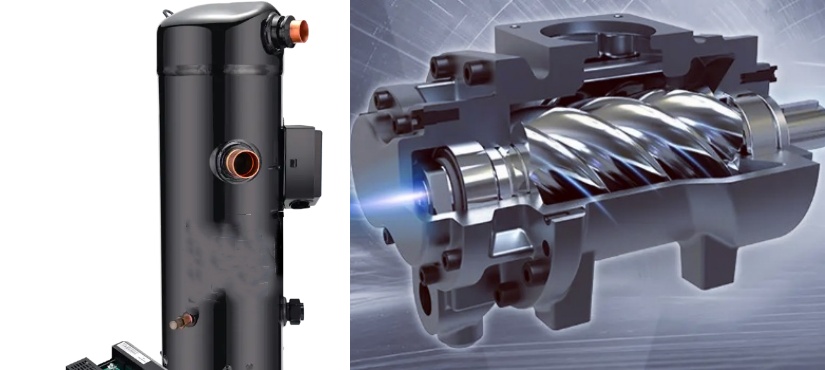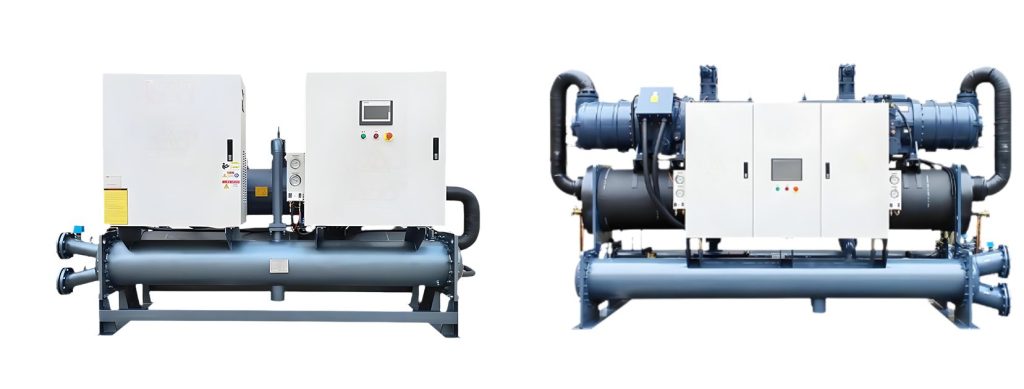Scroll Chiller vs Screw Chiller:How to Choose the Right One?
When you decide to choose an industrial chiller for a new project, you must first choose the right type of compressor. Refroidisseurs à spirale and screw chillers are two common types, and they have their own advantages and suitable applications.
In this article, you will learn the difference between scroll chillers and screw chillers. By comparing their working principles, cooling capacity, power, cost, and applications, you will know which one is more suitable for you.
What’s the Difference Between Scroll and Screw Chillers?
Principe de fonctionnement
The main difference between scroll chillers and screw chillers is the type of compressor.
Scroll Chiller-The compressor of a scroll chiller consists of two staggered scrolls. One scroll is fixed and the other is movable. The movable scroll rotates in cooperation with the fixed scroll to compress the refrigerant gas.
Screw Chiller-The compressor of the screw chiller uses two screw rotors to compress the gas. The two helical rotors have different shapes and different directions of rotation. The rotors have helical grooves that allow intermeshing. As they rotate, they draw gas into the compressor and compress it.

Capacité de refroidissement
Scroll Chiller-The cooling capacity of a single scroll chiller is generally between 3kW and 200kW, and most scroll chillers are less than 30 tons. Scroll chillers support multiple units in parallel. If you want the scroll chiller to have a cooling capacity greater than 200kW, you can do so. However, the system will be more complicated and the cost will be greatly increased.
Screw Chiller-Screw chillers are known for their high cooling capacity, ranging from 100kW to 3000kW, and some screw chillers can reach higher. They can also be connected in parallel. However, a single chiller can achieve large-capacity cooling, and generally there is no need to connect multiple units in parallel.
Taille
Scroll Chiller-Scroll chillers are mostly modular in design. These units are designed to be compact, typically measuring less than 2 meters in length, width, and height.You can easily put a 20-ton chiller (about 70kW) in an elevator.
Screw Chiller-The compressor used in screw chillers is relatively long, and its condenser and evaporator are generally large shell and tube type. Therefore, it is large in size and weight, and you need to provide it with a large independent space.

Noise
Screw Chiller-The noise of the chiller generally comes from the compressor. The scroll chiller’s compressor makes about 50 to 65 decibels of noise during operation (normal conversation is around 60 dB).Some brands of compressors can control the noise within 50 decibels.
Screw Chiller-The noise of the screw chiller is generally louder, generally between 70 and 85 decibels. Especially at startup, the noise of the compressor is very obvious. Because the two rotors of the screw compressor mesh with each other, it will make a sound. If your screw compressor is air-cooled, the fan it is equipped with will also make noise.
Cost
The cost of scroll chillers and screw chillers is generally compared in terms of procurement, installation, operation, maintenance, etc.
Scroll Chiller-The structure of the scroll chiller is relatively simple, and the cooling capacity is small, so the procurement cost is relatively low. It generally adopts a modular design, with few supporting parts, and is very simple to install. The efficiency of the scroll chiller is high when the load is relatively small, and it will be more energy-efficient if you use a variable frequency compressor. Because of its simple structure, its maintenance is also more convenient.
Screw Chiller-Screw chillers are large equipment with many parts and complex structures, and they need to be equipped with large cooling towers or fans. This increases its purchase, installation and maintenance costs.
>>Want a cost-effective chiller? Explore our best-selling Screw Chiller.
Maintenance
Scroll Chiller-Scroll chillers have a simple structure and fewer moving parts. Daily maintenance mainly involves cleaning the condenser, evaporator, checking the circuit and refrigerant,changing filters, etc. scroll chillers are easy to repair. However, if the compressor is damaged, it is usually replaced as a whole.
Screw Chiller-Screw chillers have a complex structure and the internal components of the compressor are relatively precise. During daily maintenance, it is necessary to check the lubricating oil, bearings, motor status, etc. It is difficult to maintain and requires maintenance personnel to have relevant qualifications. It has more replaceable parts, but the accessories are more expensive.
Continuous Operation and Life Cycle
Scroll Chiller-Scroll chillers are generally used for intermittent operation or short- to medium-term process cooling, with an operating time of less than 24 hours a day. Its average service life is about 8 to 12 years.
Screw Chiller-Screw chillers are designed for all-weather operation and high-load conditions. It has higher reliability and a longer life cycle, generally 15 to 20 years.The actual lifespan depends on usage intensity and routine maintenance.
Application
Scroll Chiller-Scroll chillers are generally used in low-load conditions and are suitable for some small projects or places with low cooling requirements. For example, laboratories, small process flows, medical equipment cooling, etc. It is generally installed in a small machine room or on the roof.
Screw Chiller-Screw chillers are generally used in large industrial processes and are suitable for continuous process cooling. For example, chemicals, pharmaceuticals, large cold storage, heavy industry, etc. Large HVAC systems also use screw chillers. Due to its relatively loud noise, it is generally installed in a machine room or on the ground away from people.
Which To Choose For Your Application?
If you don’t know how to choose between scroll chiller and screw chiller, you can refer to this table.
| Question | If Your Answer Is | Recommended Type |
| Is your cooling capacity requirement large? (Over 50 RT / 175 kW) | Oui | Refroidisseur à vis |
| Do you operate the chiller more than 16 hours per day? | Oui | Refroidisseur à vis |
| Is the equipment used in an heavy industrial environment? | Oui | Refroidisseur à vis |
| Is noise a critical concern? | Oui | Refroidisseur à spirale |
| Is space limited or do you need a compact design? | Oui | Refroidisseur à spirale |
| Is your budget limited? | Oui | Refroidisseur à spirale |
| Do you want simpler maintenance? | Oui | Refroidisseur à spirale |
| Do you need strong cooling capability? | Oui | Refroidisseur à vis |
Conclusion
Scroll chillers and screw chillers have their own advantages and suitable applications due to the different compressors. You should make a choice based on your cooling needs, installation environment, budget and other information.
If you still have questions about this, LNEYA chiller experts are happy to help you. We provide a variety of industrial chiller systems, whether it is a standard model or a custom chiller. Just ask!
FAQ

LTZ -60℃~-10℃
screw chiller plant
Cooling capacity 6.2~31.7kW
précision de la température ±0,5℃

LTZ -80℃~-30℃
water cooled screw chillers
Capacité de refroidissement 3,7kW~30kW
précision de la température ±0,5℃

LTZ -110℃~-50℃
industrial water coolers
Capacité de refroidissement 3,7kW~30kW
précision de la température ±0,5℃

LTZ +5℃~300℃
outdoor chillers
Capacité de refroidissement 4kW~20kW
Puissance de chauffage 3,5kW~15kW
précision de la température ±0,3℃

LTZ -25℃~5℃
large water chillers
Cooling capacity 0.7~11.5kW
Puissance de chauffage 2,5kW~10kW
précision de la température ±0,3℃

LTZ -45℃~-10℃
screw water chillers
Capacité de refroidissement 23 kW~155 kW
Pump 5m³/h~28m³/h 2bar
précision de la température ±0,5℃
CONTACTEZ-NOUS
TEL:
EMAIL:
WeChat et WhatsApp:

Wechat QR

Vous avez une question ou besoin d'un devis ? Remplissez le formulaire ci-dessous et notre équipe vous répondra sous 24 heures.
 LNEYA Industrial Chillers Fabricant Fournisseur
LNEYA Industrial Chillers Fabricant Fournisseur










